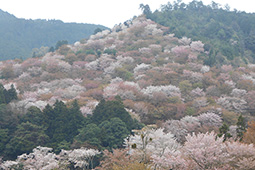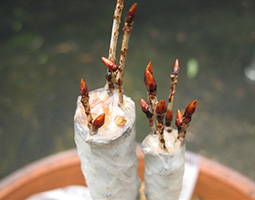INDEX
- English
- 日本語

Katsuki Toshio, a team leader at the Tama Forest Science Garden at the Forestry and Forest Products Research Institute, with Kumanozakura blooming behind him - English
- 日本語

Kumanozakura blossoms

Cherry blossoms on Mt. Yoshino 
Grafting
April 2021
Sharing the Love for Cherry Blossoms

Cherry blossoms are one of the most familiar flowers to the Japanese people. We asked Katsuki Toshio, a team leader at the Tama Forest Science Garden at the Forestry and Forest Products Research Institute, about the history and characteristics of cherry trees in Japan.

How many wild species of cherry tree are there in Japan?
There are approximately 100 wild species of sakura (cherry trees) distributed across Asia, North America, Europe and other parts of the Northern Hemisphere, and 10 wild species in Japan including Yamazakura (Cerasus jamasakura, Japanese mountain cherry). In addition, there are more than 100 cultivars in Japan that have been artificially bred from wild species. One of the representative cultivars is ‘Somei-yoshino’ (Cerasus × yedoensis ‘Somei-yoshino’), which is thought to be a hybrid of the Edohigan (Cerasus itozakura, Spring cherry) and Oshimazakura (Cerasus speciosa, Oshima cherry) species. It is not a particularly old cultivar, with commercialization dating back to the mid-nineteenth century when the people of Somei Village in Edo (present-day Toshima City, Tokyo) began to sell it under the name Yoshinozakura, which derives from Mt. Yoshino, a famous Yamazakura viewing spot in present-day Nara Prefecture.

Why is ‘Somei-yoshino’ such a familiar cherry blossom across Japan today?
Because its large petals and beautiful blossoms are well suited for appreciation. Also, the tree grows fast and becomes large enough for blossom viewing within approximately five years of it being planted. Since the Meiji period (1868–1912), when people started planting ‘Somei-yoshino’ in parks, schools and other public places, the cultivar has spread all around the nation. ‘Somei-yoshino’ is propagated by grafting. Grafting is a method for growing trees by inserting the scion of a parent tree for propagation into the top of rootstock that is cut close to the ground. By this method, it is possible to stably propagate cherry trees with blossoms that are the same size, shape and color as those of the parent tree.

In 2018 your identification of the Kumanozakura (Cerasus kumanoensis, Kumano cherry) was published and recognized as Japan’s first new species of wild cherry in approximately 100 years. Please tell us about it.
Kumanozakura grows wild in mountainous areas across Mie, Nara and Wakayama Prefectures. It looks like Yamazakura and was thought to be one of the variations of Yamazakura, so it had not been recognized as an independent species. I feel that Kumanozakura blooming in a natural forest have a simple beauty, different from the gorgeous cherry blossoms that bloom in various gardens and parks. It starts to bear its faint pink flowers when the tree is relatively young and small, so it is suited for ornamental purposes. However, there are some problems when it comes to conserving the wild Kumanozakura. For example, adequate sunlight is necessary for the growth of young trees, but the area of forests affording sufficient sunlight is decreasing due to inadequate forest regeneration, and there are other problems such as feeding damage by wild animals including deer and crossbreeding with alien species of cherry. For these reasons, I established an association this February (2021) and started Kumanozakura-related activities including research, conservation, planting, growing and finding ways to put the trees to use for tourism. In cooperation with local communities, I hope to pass down the beauty of Kumanozakura to future generations.
Many people have visited Japan from abroad to see the cherry blossoms, although the number of tourists has recently decreased due to COVID-19. Is there anything in particular about cherry blossoms in Japan that you would like to draw foreign tourists’ attention to?
I hope that in addition to enjoying the blossoms visitors will also consider the history and culture of cherry blossom viewing in Japan. For example, Mt. Yoshino is one of the sites in the UNESCO World Heritage “Sacred Sites and Pilgrimage Routes in the Kii Mountain Range.” Approximately 30,000 Yamazakura and other cherry trees are planted on the mountain. It is believed that the first to plant those trees were worshippers at Kinpusen-ji temple, which is said to have been founded on Mt. Yoshino in the late seventh century. It is worth noting that people’s efforts have made it possible to pass down many cherry trees for more than one thousand years.
Also, there are a number of giant cherry trees and ancient cherry trees in every region of Japan, many of which have been designated as natural monuments by the national or local government. I hope foreign visitors will take an interest in such cherry trees, which have characteristics peculiar to each region, as well as in the history, culture and conservation activities related to these cherry tree.

